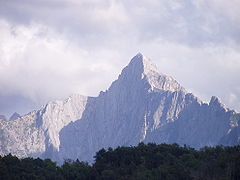

| Apuan Alps | |
|---|---|

Apuan Alps seen from Pietrasanta.
| |
| Highest point | |
| Peak | Monte Pisanino |
| Elevation | 1,946 m (6,385 ft) |
| Coordinates | 44°08′01″N 10°12′52″E / 44.13361°N 10.21444°E / 44.13361; 10.21444 |
| Geography | |
| Country | Italy |
| Region | Tuscany |
| Parent range | Apennine Mountains |
| Geology | |
| Age of rock | Triassic |

The Apuan Alps (Italian: Alpi Apuane) are a mountain range in northern Tuscany, Italy. They are included between the valleys of the Serchio and Magra rivers, and, to the northwest, the Garfagnana and Lunigiana, with a total length of approximately 55 kilometres (34 mi).[1]
The name derives from the Apuani Ligures tribe that lived there in ancient times.
The mountain range is known for its Carrara marble. Due to its extraction height environmental impact, the No Cav movement strongly opposes this activity.[citation needed]

The chain formed out of sea sediments in the middle Triassic period, somewhat earlier than the rest of the Apennines, and on a rather different geological structure.[1] Over time, these sediments hardened into limestone, dolomite, sandstone, and shale.[1] Harsh pressure approximately 25 million years ago transformed the limestone in many places into the Carrara marble (named for the nearby city of Carrara) for which the range is renowned.[1] Erosion carved much of the remaining sedimentary rocks into a jagged karst topography.
The No Cav environmental movement is fighting for the closure of the marble quarries in the Apuan Alps due to their environmental impact.
![]() Media related to Apuan Alps at Wikimedia Commons
Media related to Apuan Alps at Wikimedia Commons
| International |
|
|---|---|
| National |
|
| Other |
|